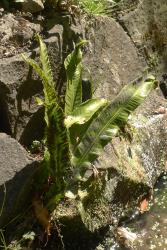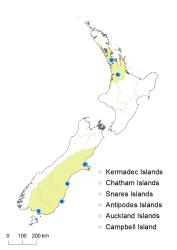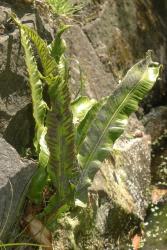- ≡ Phyllitis scolopendrium (L.) Newman, Hist. Brit. Ferns, ed. 2, 10 (1844)
Terrestrial ferns. Rhizomes short, erect, bearing scales. Rhizome scales ovate or narrowly ovate, 4–10 mm long, 0.7–1.5 mm wide, pale brown, clathrate. Fronds 140–500 mm long. Stipes 30–200 mm long, pale brown or sometimes dark brown proximally, bearing dense narrowly ovate scales with short filiform apices. Laminae entire, narrowly elliptic or narrowly oblong, 120–300 mm long, 18–47 mm wide; apex acute or acuminate, margins entire and slightly undulate, bases with two expanded lobes clasping the stipe; both surfaces light green; herbaceous, lacking hairs; scales on the abaxial surface of the midrib, becoming scattered on the adjacent lamina. Sori away from margins, in pairs along both sides of a vein, occupying half or more of the width of the lamina; indusia 5–20 mm long, straight, those of a pair opening towards each other; free margins of indusia entire. Mean spore size 33–39 μm long, 26–31μm wide; perispores reticulate with crests and ridges.
Asplenium scolopendrium is immediately recognised by its entire laminae with expanded lobes at the base, sori elongated along the veins and arranged in pairs either side of a vein, the indusia in each pair opening towards each other.
North Island: Auckland.
South Island: Canterbury, Otago, Southland.
Altitudinal range: 20–100 m.
A European and Asian species, which is naturalised in wooded parts of Hamilton, Christchurch, Waimate, Dunedin, and Invercargill. An image of a specimen from Dee Stream, Clarence River, Marlborough, has also been seen (Courtney, pers. comm.).
Occurs on the ground or on steep banks or rock walls under open kahikatea forest and introduced woodland.
Molloy (1976). Voucher: CHR 385963, 1976.
Brownsey (in Webb et al. 1988) treated Asplenium scolopendrium in Phyllitis (see Taxonomy under Aspleniaceae).






